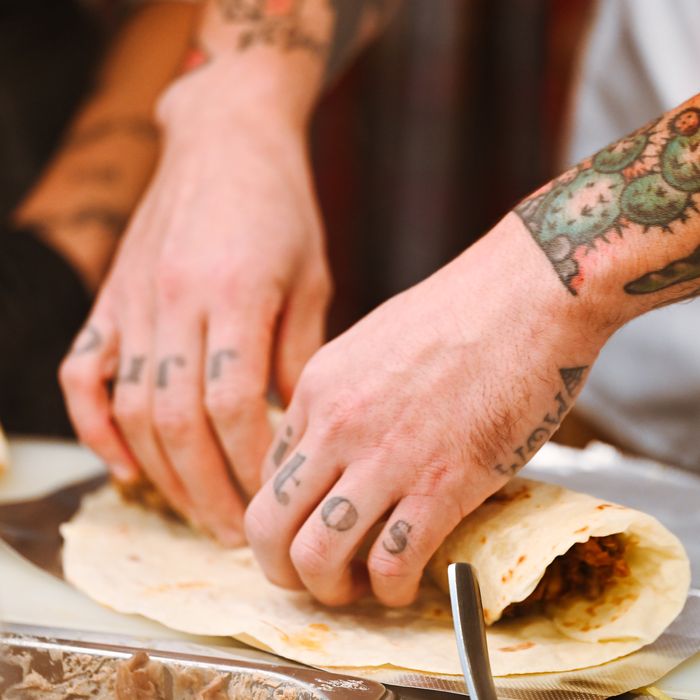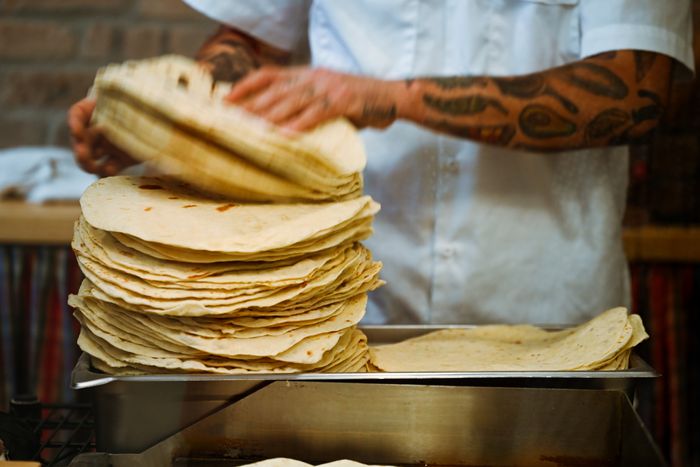
The burritos are simpler, slimmer, and better than what most New Yorkers are used to seeing.
Photo: Bobby Gallagher
At 11:30 a.m. on a recent Sunday, a line had already started to form on Myrtle Avenue outside of Los Burritos Juárez, a small red storefront that opened in August and sells out every day. “That’s pretty much the norm now,” said the chef and owner Alan Delgado looking at the line.
People make the trip to the border of Fort Greene and Clinton Hill because Delgado’s burritos are different from anything else in the city. They’re Juárez-style, longer, slimmer, and far simpler than their rice-and-cheese–stuffed, “guac is extra” Americanized cousins. For one thing, there is no rice. Just a thin layer of beans and a spoonful of slow-simmered guisado in one of four varieties: pork braised in red chile, beef and potatoes in salsa verde, frijoles con queso, and chicken mole.
In an inversion of the usual burrito math — where the tortilla is a vehicle for the fillings — Delgado’s relatively austere burritos are a showcase for his flour tortillas, puffed on a griddle and pillowy soft. Delgado grew up in and around El Paso, Texas, and he remembers how he felt when he ordered a burrito after leaving home: “I was quite insulted.” He’d first moved to Brooklyn in 2020 to become the director of R&D at Oxomoco in Greenpoint, be he was soon devoting himself to his tortilla manifesto (“For too long, the flour tortilla has been bastardized…”) and the pursuit of a better burrito. Working out of his apartment and at pop-ups, he embarked on an “endless quest” to perfect his own.
The first problem presented itself early in the process: Prior to this, he didn’t have any professional experience working with dough. “What I did know was how I wanted it to taste — I was chasing the memory of being a kid in Juárez and El Paso, eating those incredible tortillas,” he says. So he experimented with different flours, fats, water temperatures, kneading times, resting periods, rolling methods, even how long to let the dough relax between steps. “Each time a tortilla puffed just right or tore the way I remembered, it felt like I was getting closer to home,” he says.
It took four years to land on the lard-based version he uses today. At the store, balls of dough are rolled into thin, round discs on a flour-dusted wooden counter, then cooked on the griddle until they puff, blister, and char in spots. From there, it’s a quick assembly – a smear of beans, a spoonful of filling, a quick roll, foil wrap, and done.
Over the rustle of foil being unwrapped, you might hear someone sigh, “Oh my gosh, this is so good,” or ask half-jokingly, “Can I buy a dozen of these?” (The answer: You can buy a pack of three for $6.)
Mostly what you see at the store are customers who, after a lifetime of store-bought tortillas and fast-food burritos, are tasting the real thing for the first time. “They’re fluffy, they’re light, they’re savory,” said Hunter Adams, a customer who made the trip to Los Burritos Juárez after hearing about it on social media.. “It’s like a hug that’s so comforting.”

A stack of fresh tortillas at Los Burritos Juárez.
Photo: Bobby Gallagher
EAT LIKE THE EXPERTS.
Sign up for the Grub Street newsletter.
Vox Media, LLC Terms and Privacy Notice


Dining and Cooking